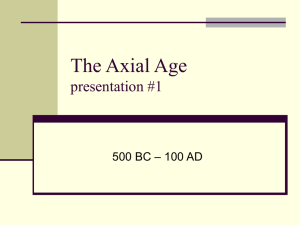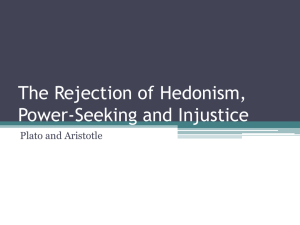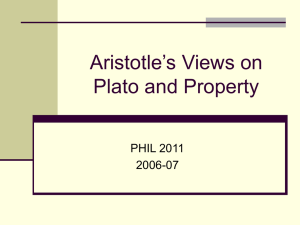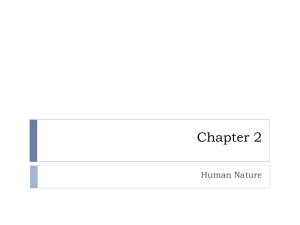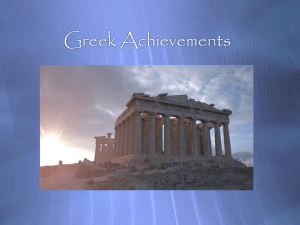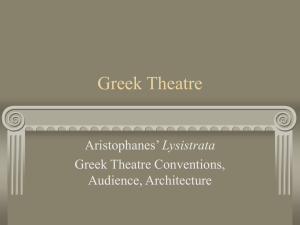The Axial Age - World Civilization I
advertisement
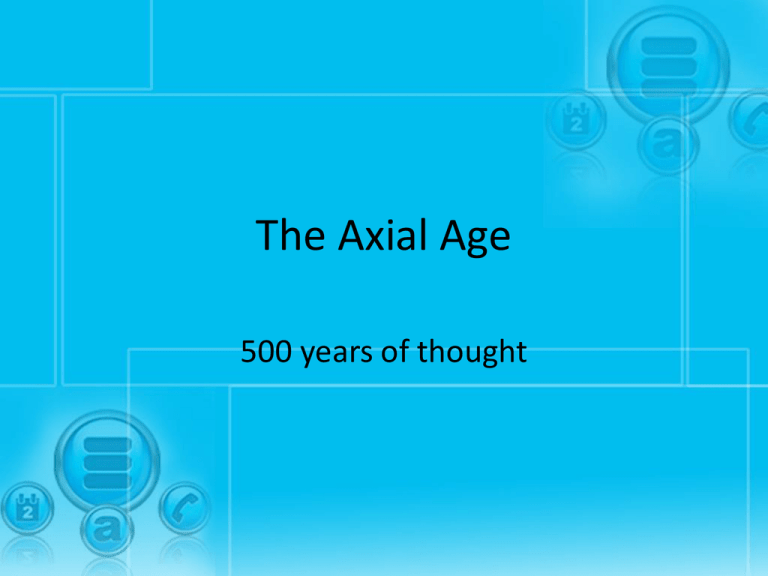
The Axial Age 500 years of thought What is the Axial Age • First great age where the thoughts of different sages is written down • Much of the ideas written down would influence later thought across nations – Religious leaders – Secular leaders • Focus on China, India, Greece and SW Asia Thinkers of the Age I. Thoughts of the sages written down took hold gradually, (sacrilege to write/confide to writing) II. Eurasia’s several sages I. II. III. IV. Iran/Persia: Zoroaster (insecurely dated) Ahura Mazda: Single deity of good Dual forces that shape the world good/evil Forces of light belong to Ahura Mazda, darkness Ahriman V. Notion of Good and Evil that dominates mainstream thinking for 1000 years India I. Texts of the Veda multiplied/handed down by Brahman, moral implications of religious life II. Vardhamana Jnatrputra: 6th or early 5th century BCE, aka Mahavira “the great hero”, founder of Janism III. Janism: A way of life to free the soul form evil by asetic practices: Chastity, detachment, truth, selflessness - - - I. Janism is such a religious life that a member could only accept what is freely given preferring starvation to an ungenerous life. India IV. Buddhism A. B. C. D. Gautama Siddharta: lived between 6th and early 4th century BCE Tradition of life he came up with is a Code of Life rather than religion. Never appears to have made any assertions about a God. Called the Buddha, or Enlightened One Objective for Buddhism is to escape desire – the cause of unhappiness, A. B. C. Meditation Prayer Unselfish behavior of varying intensity for different individuals according to their vocation. India IV. Buddhism E. Aim of Buddhism: Nirvana “extinction of the flame”. Some gather in monasteries to help guide each other toward this end F. Early texts, cling to idea of the self survives the death of the body – perhaps many deaths G. Famous text from China, Buddha promises a righteous person can be born an emperor for eons, and could remember past lives India IV. Buddhism H. Old/New Religion? 1. 2. Some argue that this is really a form of old pagan practices May be true, but they are NEW because they upheld effectiveness of moral practice, along side formal rituals to adjust the relationship with nature or with whatever is divine. Significance of Jews in 2nd part of 1st Millennium I. Religion – influence 2 other religions (Islam, Christianity) II. Eastern Europe, Jewish communities were strong in est. towns and worked as artisans III. Chroniclers A. B. C. Documented where they inhabited in the in the zone between Mesopotamia and Egypt, west of Dead Sea and the River Jordan Arrived during a period of war and wandering after enslavement in Egypt Moses led them or liberated them, no other evidence confirms this. Significance of Jews in 2nd part of 1st Millennium III. Chronicles D. 8th and 9th century BCE neighboring people through their writings confirm and illustrate the essential features of the story told in Jewish writings. Most Jews were in Jordan Valley around this time (farming) E. Women’s role 1. 2. 3. Valued as producers of children, and labor Suitors had to pay a bride price, could be years of labor to the family Many women, even to date, have few rights under Jewish law. Significance of Jews in 2nd part of 1st Millennium IV. Jewish Kingdoms (Judah, Israel) A. Often fought each other, had unity at times B. Writers recall the ideal times of power under Kings Saul, David and Solomon C. Function of the state: 1. 2. warehouse food, defend it from invaders. Administer justice, (bible full of examples) D. These kingdoms also subject of invasion as evidenced by records, Jews would be dispersed again. Significance of Jews in 2nd part of 1st Millennium V. Jewish Identity: despite traumas of 7-5 centuries BCE, Expressed in writings of the Torah (1st 5 books of bible) 1. Did not turn from their God at this period, reevaluated relationship, one true God 2. Suffering was the trials of faith and punishment for sins, especially failure to acknowledge God’s Uniqueness (10 Commandments) 3. Deliverance is in the next life, reward for fidelity in this life 4. Living by the Talmud (rabbinic commentaries of life, law, and culture, and every day life) Significance of Jews in 2nd part of 1st Millennium VI. Last Great Teacher 1. Jesus who died around 33 CE. 2. Greatest in terms of the scale of his influence 3. Controversial in that his followers were the ones who collected and wrote down his teachings. 4. We have almost no independent confirmation that he existed. 5. Better information about Jesus than other figures during this period. 6. Collections of his teachings were collected approx . 30-40 years after his death, making them a bit more reliable. Significance of Jews in 2nd part of 1st Millennium VI. Last Great Teacher 7. Secularly: Considered an independent minded Rabbi with radical message 8. Followers called him “Christ”, corruption of Greek Hamashiad, or messiah, anointed one 9. Anointed one was to designate the King they hoped for at the end of history to bring heaven to earth. 10. Message was uncompromising: Priesthood needed to be purged of corruption, temple at Jerusalem “cleansed” of money changers, 11. Biggest claim was that humans could not gain divine favor by appealing to a kind of bargain with God – the Covenant of the Jewish Tradition – God freely gave or withheld favor or grace 12. Humans were dependent upon God’s grace. Summing Up Axial Age Thinking I. Teachers of age were highlighted in a world that had increasing numbers of new religions, most did not survive. II. This is a period that the distinction between a religion and secular life begins. Spiritual firmament was always apart of intellectual innovation. I. We cannot say that Confucius founded a religion, but we cannot think of his ideas as purely secular Summing Up Axial Age Thinking III. Secular thinkers A. Greek sages emerged during this age along side the founders of the new religions of Asia B. Aristotle, Athenian Aristocrat Plato C. Aristotle left great body of work on science, logic, politics, and literature, that has no equal in the West for centuries D. The whole of western philosophy since the classical age of Athens in the 4th BCE has been footnotes to Plato E. Other thinkers in Asia and Asia minor parallel these ideas of scientific and logic. Thoughts of the Axial Age A. Idea of a God, divine creator responsible for everything in the universe. B. Creation: new ideas of creation, The idea A creation story, before just how the universe became what it was C. Idea of “nothing” is introduced. Beyond experience, uttermost limits of though. “nothing” allowed thinkers to reformulate their ideas of the order of nature D. Greece, 5th Century BCE: Leucippus devised the atomic theory – matter is not a continuous whole but is composed of tiny particles. Thoughts of the Axial Age • E. Jews; provide most challenging thoughts of creation from nothing, also new philosophical twist to divine thinking • F. Conclusions followed – A creator was unique, no predecessor – He was purely spiritual – Eternal existence outside our ideas and notions of time, he is not a “product” of creation; unchanging, nothing greater exists, his power has no limits Thoughts of the Axial Age G. Monotheism: one unique God, has power over nature, new idea H. China, Buddhists dispensed with creator alluding to the everlasting influence of the universe, and endlessness of it 1. Greeks had a hierarchy of Gods 2. Indians had (good and evil) Thoughts of the Axial Age I. Divine Love 1. 2. J. Greeks ignored the idea that once a god created he remained interested in his creation Aristotle felt that God being perfect needed nothing else (thus not interested in his creation) Axial age belief that God’s interest was specifically focused on them, humankind was special 1. 2. 3. 6th Century BCE, philosophers: taught that “all things that are born with life in them should be treated as kindred Aristotle developed a hierarchy of living souls in which human souls were superior to those of plants and animals, due to human’s ability to rationalize. Xunzi: Chinese described later in the next century that Man has spirits, life, and perception, and a sense of justice; his is the noblest of all earthly things Thoughts of the Axial Age L. Humankind’s place in creation opened question of whether they were its lords or stewards. 1. Special relationship with God: Jews began to use the idea of divine love to express this relationship. 2. Jesus seized upon the identification of God and love, it was emotionally satisfying, love is a universal emotion, it freed people from the problems of everyday life. This made Christianity become universally accepted, eventually. New Political Thinking I. Two Contrasting Political Ideas A. Those that emphasized Freedom (to release human goodness) B. Those that emphasized discipline (to restrain human wickedness C. The state was an agent for Virtue D. Biblical account of Genesis is most widely expected compromise. God created humans good and free. New Political Thinking I. Two Contrasting Political Ideas E. Abuse of Freedom made people bad??? Unpersuasive?, If Adam was good, how could he use freedom for evil? F. Thus the invention of Diabolical devises (serpent) corruption of goodness from outside G. Genesis leaves politics with a difficult balancing act between freedom and force. New Political Thinking II. Political Pessimism A. B. C. D. Plato: The way to overcome human deficiencies was to strengthen the state, The Republic was a harsh ideal state with strict rules. Objections to Plato: censorships, repression, militarism, regimentation, extreme communism, collectivism, selective breeding of superior stock of humans, rigid class structure, active deception of people by the state, all distressful Key: Plato was that political power should be concentrated in a self electing class of philosopher rulers “kings” called guardians. Reasoning of Plato still has appeal to state builders, The Guardians become the inspiration and intellectual ancestors of the elites that will rule New Political Thinking III. Political Pessimism – Chinese A. More severe than Plato B. The ruler should be bound by law, (Aristotle agreed), but Confucius said that ethics should override obedience to law. The age old tension between rulers and rights. C. 4th century China – Legalist School of thought, virtue – or pretended virtue – was needed. The principal of goodness was meaningless D. Society required only obedience. What the law actually said was irrelevant, Morality was nonsense. New Political Thinking E. Difference in Chinese thoughts: 1. Previous ideas and thoughts of human law tried to make human law more moral by aligning it to divine law 2. Chinese legalists were reacting against generations of disastrous feuding among the warring states. The ethics of Confucians did not prevent this warring atmosphere 3. The only good was the good of the state. Law and order were worth tyranny and injustice. Ethics was a “gnawing worm” that would destroy the state. Political Optimism I. Most Sages of Axial Age were optimistic. They did believe that human nature was good A. Confucianism decided that the state should liberate subject to fulfill their potential B. Greek sages advocated democracy that entrusted citizens (not women or slaves or children) with a voice in the affairs of the state. C. For Chinese thinkers did have similar individualistic doctrines , but these did not question the role of monarchy. Confucius advocated a return to a golden age supposedly at the founding of Zhou. Political Optimism II. Greek Sages A. The state was a mechanism to be tinkered with as needed (republican, aristocratic, democracy) B. Aristotle, first political scientist, made a survey and study of Greek political systems 1. 2. 3. 4. Thought Monarch was the best system in Theory. Aristocratic Government more practical, manageable number of superior men to administer the state Democracy, good idea, led to mob rule Best system: mixed in which aristocracy predominated, under the rule of law. Embodied in the Roman state of the 2nd half of the millennium. Model for Western Government. Political Optimism III. Jesus A. New commandment: “love one another” to replace all laws. B. Kingdom of Heaven was more important than even the Roman Empire (this world is of little importance) C. The Great ironic Joke: Render unto Caesar what is Caesar’s and unto God what is God’s. In other words all Jews understood this to mean to despise or even to ignore the state, for everything, to the Jew’s, was God’s. It is an invitation for Civil Disobedience Political Optimism III. Jesus D. Jesus was dangerous for the state, he welcomed social outcasts as his followers – prostitutes, tax collectors, “sinners”, and people from Samaria who were despised by the Jews as both sinners and heretics. E. He favored the weak (children, women, the lame, the blind, beggars, the meek) against the powerful and promised them that they would inherit the earth. F. This radical bias caused both Roman and Jewish authorities to put him to death Challenging Illusion & Magic A. Breakthroughs in mathematics 1. 2. 3. Indians “discovered” it idea of “nothing”, and Infinity, numbers were limitless Geometry: showed how the mind could each realities that the senses obscure, (circle , line) Reality could be invisible, untouchable and ACCESSIBLE to Reason. B. Pythagoras 1. 2. 3. 4. Musical harmonies can be expressed as arithmetical ratios Consistent ratios characteristic of right angled triangles Formulated the notion of real numbers, used to classify objects (2 flowers, etc) Numbers exist apart from the objects they enumerate. Exist even if there were nothing to count. Challenging Illusion & Magic C. Reason 1. Parmenides: Greek from southern Italy, if geometrical figures were real, you believe in truth of a super sensible world – for example the perfect square 2. Reason opened the caverns of the mind, where truths lay. 3. Rationalism: an escapist alternative to reality, Parmenides thought he could prove that change was illusory and differences deceptive, and that only \ and eternal were real Challenging Illusion & Magic C. Reason 4. Zeno a. b. D. E. Teachers of India and Greece, China showed intense interest in proposing rules for correct use of reason Aristotle’s common sense into intelligible rules. To this day these rules are used without us knowing about it. He was the best analyst of how reason works, if it works at all 1. 2. F. An arrow in flight always occupies a space equal to its size, therefore it is always at rest. Matter is invisible because “if a rod shortened every day by half its length, it will still have something left after ten thousand generations.” He would take valid arguments and brake them down into phases, Syllogisms, in which we can infer a necessary conclusion from two premises that prior demonstration or agreement have established to be true. All men are mortal, Socrates is a man, if follows that Socrates is mortal Nyaya School of commentators in India analyzed logical processes in 5 stage breakdowns that resemble Aristotle’s syllogisms. Science A. Starts with the distrust of the senses Lu Shi Chong Quiz in 3rd century actually able to see that some metals were softer than others and could be combined to create harder ones B. Sought to penetrate the veil and expose underlying truths. Democritus in the 5th and early 4th century stated that “truth lies in the depths.” C. Idea of supernatural and natural developed at this point, In 650 BCE The Chinese Shen Xu is said to have taught that ghosts were just the producers of the fears and guilt of those who see them. Science D. Confucians deterred his followers from thinking of the dead until they know the living E. Confucians professed interest in human affairs – politics and practical morality – and were indifferent to the rest of nature, except to dig out superstition Science E. Greeks, origins are inseparable from magic 1. Nature worship, and shamanistic attempts to penetrate the mysteries of the unseen by right and ecstasies. 2. Omens and Ideas were thought to be understood through Magic 3. Science needed a methodology : Aristotle was the best representative of Greek science, we must have facts, he stated, and proceeded to gather them. 4. Archimedes: discovery of the lever 5. Erastohenes produced almost exactly accurate calculation of the size of the earth Science F. Chinese Science 1. Daoist doctrine of nature, habits of observation and experiment developed from the magical omen seeking practices of early Daoism 2. Word for “temple” means watchtower – a platform from which to observe the natural world and launch explanations of its phenomena. 3. Daoism encouraged the beginnings of scientific practice; observation, description, classification, and experiment Medicine A. Greece 5th century BCE, Hippocratic school. Secular school, 1. Health was essentially a balance among 4 substances in the human body 2. Blood, Phlegm, black and yellow bile 3. Adjust the balance & you alter the patients state of health 4. Condemned patients in the West to centuries of treatments that relied on diet, vomiting, laxatives, and bleeding. 5. Hippocrates felt that the body was not harmed by Gods but by disease that affects the body Medicine B. Chinese & Hippocrates started a presumption that nothing needs to be explained by the divine. C. India, closely applied similar learning. The Arthaveda, earliest known work of Indian medicine, diseases and demons are more or less identical and are treated with charms or drugs. D. From 6th century the emergence of professional schools of medicine with training and literature, areas are similar, but no direct historical link between Greeks, Chinese, and Indian schools of medicine Skepticism A. New line of thinking in Axial Age, world as purposeless arising out of the scientific point of view to observe with suspicion B. Aristotle’s “final cause”, the purpose of a thing that explains nature – becomes irrelevant, The world is a random event. If the world has no purpose, it was not made for human beings, who are reduced to insignificance. C. World without a purpose needs no God Skepticism D. Epicurus interpreted the Atomic Theory as – in a world of atoms and voids, there is no room for “spirits.” There is no fate, 1. Since some atoms are perishable, and everything is composed of them, there can be no immortal soul. 2. Gods if they exist all inhabit an imaginary world that we have nothing to hope and nothing to fear. Skepticism E. Greek schools 1. Greek schools reformulated and refocused their philosophy on practical issues. 2. The Stoics was one of these schools focusing in on the best practical choices for personal happiness. 3. Stoicism appealed to the Roman elite and though them had an influence upon Christianity 4. Zeno of Athens in the late 4th century it started from the insight that nature is morally neutral, only humans act as good or evil. Skepticism E. Greek Schools 5. Stoic ideas of acceptance of fatalism and indifference for remedies for pain were similar to Buddha and his followers. 6. Most effective in the West. It supplied the source of guiding principles of the ethics of most Western elites since its emergence. Summing it Up I. There are several parallels in thought during the 500 years leading up to the Christian era. II. Often in the areas that boarder each other influence was shared III. Era was central to the key changes in religion and changes in secular leaders raised questions of human nature and of how we can devise appropriate social and political solutions to this problem.
